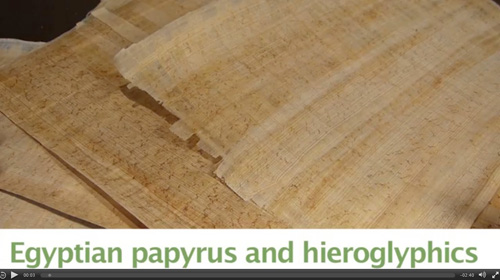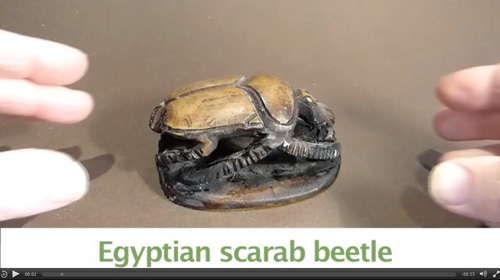|
|
Stone Age
|
 Stone Age stone circle
Stone Age stone circle
Investigating a stone circle in the Lake District.

|

|
 Stone Age axes through the ages
Stone Age axes through the ages
How stone tools changed during the Stone Age.

|

|
 Stone Age hand axe
Stone Age hand axe
A hand axe was an object shaped to fit comfortably in the hand.

|

|
 Stone Age cutter flint
Stone Age cutter flint
This thin blade might have been for skinning animals.

|

|
 Stone Age arrowheads
Stone Age arrowheads
Wooden arrows were either given a sharp point or a stone head was added.

|

|
 Stone Age henge, Avebury
Stone Age henge, Avebury
Avebury has the world's largest stone circle with ditch and bank. It is a henge.

|

|
 Stone Age long barrow
Stone Age long barrow
This is a reconstruction of a chieftain's burial site on a ridgetop. There is also footage from an actual burial site at Wayland Smithy.

|

|
Celts/ Bronze Age/ Iron Age
|
 Brooches
Brooches
Two different styles of decorative brooch used to fasten clothes.

|

|
 Cloaks
Cloaks
Examples of the sort of cloth used to make cloaks and blankets in Bronze Age and Iron Age Britain.

|

|
 Cloth
Cloth
Examples of the sort of cloth used to make tunics in Bronze Age and Iron Age Britain.

|

|
 Currency bar
Currency bar
A metal bar that was used as a form of currency.

|

|
 Decorative beads
Decorative beads
Beads of the style worn in Bronze Age and Iron Age Britain.

|

|
 Horse bit
Horse bit
Metal horse bit used to control horses.

|

|
 Loom weight
Loom weight
W weight used to hold vertical threads in place during weaving.

|

|
 Romano-British coins
Romano-British coins
Replicas of the coins used in Britain under Roman occupation.

|

|
 Shield boss
Shield boss
Replica metal boss that would have been in the middle of a Bronze Age shield.

|

|
 Shoes
Shoes
Leather shoes of the style worn in Bronze Age and Iron Age Britain.

|

|
Egyptians
|
 Great Pyramids
Great Pyramids
The Great Pyramids near Cairo.

|

|
 Tutankhamun
Tutankhamun
This video covers the pharoahs Akhenaten to Tutankhamun.

|

|
 Papyrus
Papyrus
Papyrus and how it was used.

|

|
 Scarab beetle
Scarab beetle
Scarab beetle amulet.

|
 |
 Ramesses II
Ramesses II
Ramesses II was one of the most powerful pharoahs of Ancient Egypt.

|

|
Greeks
|
 Temple at Olympia
Temple at Olympia
The sculptures at the end of the main temple.

|

|
 Delphi, City
Delphi, City
The Greek temples at Delphi, and information on the importance of the Oracle.

|

|
 Delphi, Oracle
Delphi, Oracle
The Greek temples at Delphi, and information on the importance of the Oracle.

|

|
 Delphi, Tholos
Delphi, Tholos
The strange ruins at Delphi known as the Tholos.

|

|
 Stadium at Olympia
Stadium at Olympia
The famous Greek stadium at Olympia, where many of the ancient Olympic Games events took place.

|

|
Romans
|
 Roman Mosaic at Ostia
Roman Mosaic at Ostia
Shows a mosaic on the floor of a Roman bath in Ostia, the port for Rome.

|

|
 Hadrian's Wall
Hadrian's Wall
The famous Roman wall that marked the edge of the Roman Empire in Britain.

|

|
 The Pantheon
The Pantheon
The best-preserved Roman temple in Rome.

|

|
 The Colosseum
The Colosseum
The largest amphitheatre in the world.

|

|
 As coin
As coin
Shows a replica Roman as, which was a medium-sized coin made of bronze, alongside a Roman dupondius.

|

|
 Aureus coin
Aureus coin
Shows replica aureus coins, which were originally made from gold and worth twenty-five silver denarii.

|

|
 Denarius coin
Denarius coin
Shows replica denarius coins, which were originally made from silver.

|

|
 Dupondius coin
Dupondius coin
Shows replica dupondius coins, which was originally made from bronze and worth two and a half as's.

|

|
 Sestertius coin
Sestertius coin
Shows replica sestertii, which were large bronze coins worth a hundredth of an aureus.

|

|
 Oil lamp
Oil lamp
A replica of a decorated clay oil lamp like the ones Romans used to light their homes

|

|
Aztec/Maya
|
 Obsidian Olmec Head
Obsidian Olmec Head
A replica Olmec civilisation head. Maya and Aztec copied these designs.

|

|
Saxons and Vikings
|
 Ruthwell Cross
Ruthwell Cross
Shows the Anglo-Saxon cross at Ruthwell, Dumfries and Galloway, which was originally an outside cross where people met to pray before churches were built.

|

|
 The Moan at Canonby
The Moan at Canonby
This famous cross contains a rare 'moan'. It comes from Cumbria.

|

|
 Anglo-Saxon Churches
Anglo-Saxon Churches
Two of the best-preserved and longest-surviving Anglo-Saxon churches in England (in Northamptonshire).

|

|
 Statue of Alfred the Great
Statue of Alfred the Great
The statue of Alfred the Great in Winchester.

|

|
 Viking hog-back grave
Viking hog-back grave
A viking 'upturned-ship' stone coffin, called a hog-back grave.

|

|
Norman to Great Fire (1066 to 1666)
|
 A knight's tomb
A knight's tomb
A tomb of a Crusader.

|

|
 Egglestone Abbey
Egglestone Abbey
The ruins of Egglestone Abbey, destroyed on the orders of Henry VIII.

|

|
 Tudor patten shoes
Tudor patten shoes
Shoes like these were worn by women in Tudor times to make sure their long skirts did not trail in the muck on the streets.

|

|
 Riley Graves, Eyam plague village
Riley Graves, Eyam plague village
Graves of the Hancock family, who were victims of the plague in 1665.

|

|
The Victorians through to World War I
|
 Sailor's chest
Sailor's chest
19th century sailors carried all of their precious goods in a sturdy chest like this one.

|

|
 Flat iron
Flat iron
A Victorian flat iron compared with a modern day one.


|

|
 Cigarette cards
Cigarette cards
From 1875, cigarettes came with collectible cards featuring images and writing.

|

|
 Pen and ink
Pen and ink
Victorian pens used ink, which was put in inkpots.

|

|
 Medal for school attendance
Medal for school attendance
Victorian children who attended school every day received a medal.

|

|
 Clothes peg
Clothes peg
Clothes pegs were made from split birch twigs and twisted metal.

|

|
 School bell
School bell
School bells called pupils into class in Victorian schools.

|

|
 Soap and brush
Soap and brush
Victorians used carbolic soap and scrubbing brushes to clean.

|

|
 'Guzunder' chamber pot
'Guzunder' chamber pot
A chamber pot known as a 'guzunder' because it 'goes under' a bed for use at night.

|

|
 Teddy bear
Teddy bear
A replica teddy bear of the type invented in late Victorian times. Originals were made from goat's wool.

|

|
 Keys (used by a butler)
Keys (used by a butler)
Butlers in Victorian homes kept a set of keys to lock away valuables.

|

|
 Candle snuffer and scissors
Candle snuffer and scissors
A tool used to trim candle wicks to stop them burning too quickly, and to put out the candle flame.

|

|
 Butter paddle
Butter paddle
Wooden paddles were used to shape fresh butter into a block.

|

|
 Copybook
Copybook
Copybooks were used in Victorian schools by children learning how to write.

|

|
 Slate for writing
Slate for writing
Slate and pencils were used to write on in Victorian schools.

|

|
 Falling sticks game
Falling sticks game
A game that involved picking up individual wooden sticks in a jumbled pile without moving the other sticks.

|

|
 Finger stocks
Finger stocks
These wooden stocks were used as a punishment in Victorian classrooms. Children's fingers were placed in the holes and their hands tied behind their backs.

|

|
 Acrobatic toys
Acrobatic toys
These were wooden models that pivoted on a wooden frame and so made a moving toy.

|

|
 Ball and cup game
Ball and cup game
This toy was formed from a ball tied to a cup (like an egg-cup) with a piece of string. The idea was to throw the ball up and catch it in the cup.

|

|
 Diablo
Diablo
The aim with a diablo is to use the wooden sticks to spin a 'dumbbell' on the string until it is going fast enough to be thrown into the air and caught again on the string.

|

|
 Princess Mary Box
Princess Mary Box
The box issued to all troops on the first winter of World War I.

|

|
1920 to modern times
|
 1925 radio
1925 radio
A 'portable' radio from 1925, with a radio recording playing over the top.

|

|
 WWII Gas Mask and Warden Helmet
WWII Gas Mask and Warden Helmet
A gas mask and warden helmet that would have been used by people during the blitz in World War II.

|

|
 WWII ration card
WWII ration card
Ration cards were used when food was scarce during WWII and people could only have a certain amount of foodstuffs per week.

|

|
 Hobbies in the 1930s
Hobbies in the 1930s
A book of what hobbies were like in the 1930s.

|

|
 Toys in the 1970s
Toys in the 1970s
Mechanical toys, like these trains, were very popular in age before computers.

|

|
 Toy cars
Toy cars
Toy cars from the 1970s.

|

|
 Toy car ramp racers
Toy car ramp racers
Ramps like this wooden one were popular for racing toy cars.

|

|
 Jack in the box
Jack in the box
A Jack in the box was a popular form of toy.

|

|
 Personal computers from the 1980s
Personal computers from the 1980s
Early computers compared to those in 2010.

|

|
 Coronation cup and plate from 1953
Coronation cup and plate from 1953
Millions of cups, plates and saucers were printed specially for the coronation of Elizabeth II.

|

|
 1977 Jubilee cup and plate
1977 Jubilee cup and plate
Millions of cups, plates and saucers were printed specially for the Jubilee of Elizabeth II.

|

|
 2011 Will and Kate Royal Wedding
2011 Will and Kate Royal Wedding
Millions of cups, plates and saucers were printed specially for the wedding of the future king.

|

|




















 Papyrus
Papyrus

 Scarab beetle
Scarab beetle



























































